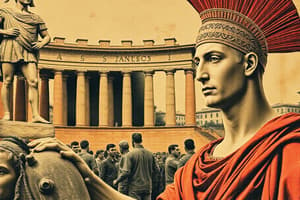Podcast
Questions and Answers
How did the Rhine River contribute to the stability and security of the Roman Empire?
How did the Rhine River contribute to the stability and security of the Roman Empire?
- It served as a key trade route, connecting Roman territories and facilitating economic growth.
- It supplied fresh water to major Roman cities, supporting a growing population.
- It allowed for rapid transportation of Roman legions, enabling quick response to rebellions.
- It provided a natural barrier, protecting the empire's eastern border from Germanic tribes. (correct)
What was the purpose of the infrastructure projects, such as roads and aqueducts, undertaken by the Roman Empire?
What was the purpose of the infrastructure projects, such as roads and aqueducts, undertaken by the Roman Empire?
- To primarily serve as decorative monuments showcasing Roman artistic skills and engineering prowess.
- To provide recreational spaces for Roman citizens, promoting leisure and reducing social unrest.
- To serve as defensive structures against enemy attacks.
- To facilitate efficient communication, transportation, and supply distribution throughout the Empire. (correct)
How did the shift from polytheism to the legalization of Christianity under Emperor Constantine impact the Roman Empire?
How did the shift from polytheism to the legalization of Christianity under Emperor Constantine impact the Roman Empire?
- It caused political instability as traditional Roman beliefs were suppressed, leading to widespread revolts.
- It led to economic prosperity due to the elimination of traditional religious festivals.
- It introduced a unifying element within the empire, but also created division between those who maintained traditional beliefs and those who converted. (correct)
- It had no significant impact on the empire as most of the population continued to practice polytheism.
How did specialization in different sectors influence the Roman Empire's economy and societal structure?
How did specialization in different sectors influence the Roman Empire's economy and societal structure?
What role did the 'Code of Justinian' play in Roman society, and what broader impact did it have?
What role did the 'Code of Justinian' play in Roman society, and what broader impact did it have?
How did Augustus Caesar's rule contribute to the transformation of the Roman Republic into the Roman Empire?
How did Augustus Caesar's rule contribute to the transformation of the Roman Republic into the Roman Empire?
How did the extensive size of the Roman Empire affect its ability to govern and maintain control over its territories?
How did the extensive size of the Roman Empire affect its ability to govern and maintain control over its territories?
What impact did economic problems, such as unpaid taxes, have on the Roman Empire's stability and longevity?
What impact did economic problems, such as unpaid taxes, have on the Roman Empire's stability and longevity?
How did Roman belief systems influence their culture and society, and what impact did it have?
How did Roman belief systems influence their culture and society, and what impact did it have?
What role did technology play in the growth and maintenance of the Roman Empire?
What role did technology play in the growth and maintenance of the Roman Empire?
Flashcards
Mare Nostrum
Mare Nostrum
The Roman Empire called the Mediterranean Sea mare nostrum, or “our sea”.
Roman Infrastructure
Roman Infrastructure
Roads, bridges, and aqueducts throughout a huge empire.
Augustus Caesar
Augustus Caesar
Improved safety, built buildings, aqueducts, flood protections, gave power to Antonius, expanded the empire, Pax Romana.
Christianity in Rome
Christianity in Rome
Signup and view all the flashcards
Roman Specialization
Roman Specialization
Signup and view all the flashcards
Roman Stable Food Supply
Roman Stable Food Supply
Signup and view all the flashcards
Roman Technology
Roman Technology
Signup and view all the flashcards
Roman Writing
Roman Writing
Signup and view all the flashcards
Roman Social Structure
Roman Social Structure
Signup and view all the flashcards
Study Notes
- This is the 4th grade study guide, Unit 4 Chapter 2, about The Roman Empire
Culture
- The Roman Empire extended along the coast of the Mediterranean Sea
- The Rhine River protected the empire from Germanic people to the east
- Romans called the Mediterranean Sea mare nostrum, or "our sea."
Infrastructure
- Roads are a key part of the infrastructure throughout the huge empire
- "All roads lead to Rome."
- Bridges, aqueducts, and buildings made up the infrastructural.
- The Empire's vast size made it difficult to communicate
Government
- The Roman Empire was ruled by emperors
- Augustus Caesar was an emperor
- Augustus Caesar improved safety, built buildings/aqueducts, and created flood protections
- Augustus Caesar gave power to Antonius
- Augustus Caesar expanded the empire
- Pax Romana occurred under Augustus Caesar's rule
- Byzantium, or Constantinople, used to be the capital of the eastern empire
- Eventually Germanic tribes took over the western empire
- Economic, monetary problems and the lack of paid taxes caused issues
Belief Systems
- Polytheism was similar to the Greeks
- Monotheism was part of the belief system
- Emperor Constantine made Christianity legal in the empire
Specialization
- Farming
- Sea trade
- Architecture
- Military
Stable Food Supply
- Olives
- Grapes
- Fish
Technology
- Arches and domed structures
- Tools and weapons
Writing
- Code of Justinian: book of Roman laws
Social Structure
- Emperor, soldiers, working class people, and slaves
Key Questions
- Be able to discuss what caused the fall of the Roman Empire.
- Be able to locate the Roman Empire on a world map
- Be able to locate the following locations on a map of ancient Rome: Mediterranean Sea, Italy, Rome, Rhine River, Alps
Studying That Suits You
Use AI to generate personalized quizzes and flashcards to suit your learning preferences.




